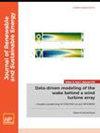Experimental assessment of a morphing trailing edge device for wind turbine blade performance improvement
IF 1.9
4区 工程技术
Q4 ENERGY & FUELS
引用次数: 0
Abstract
Nowadays, wind energy plays a central role in the renewable energy production, and the optimization of wind turbine performance is the focus of current research studies. In this context, morphing trailing edge system could be a promising solution to enhance wind turbine blades' aerodynamic performance. In this paper, an innovative morphing trailing edge system was designed, developed, and tested to improve the performance of a wind turbine blade airfoil. The trailing edge deformation is electrically operated through piezoelectric actuators and a compliant surface. Wind tunnel tests were performed for the sake of system validation at Reynolds number equal to 1.75×105 and 3.5×105 and an angle of attack ranging from −8° to 8°. The results put in evidence the effectiveness of the proposed morphing trailing edge system to enhance the aerodynamic performance. The trailing edge deformation allows to increase or decrease the lift coefficient. The mean percentage difference of lift coefficient was found equal to −83.6% and 68.4% for an upward and downward deflection, respectively. Meanwhile, the drag coefficient does not have a significant variation. Consequently, the aerodynamic efficiency will be increased or decreased keeping the angle of attack unchanged. The mean percentage difference of efficiency was found equal to −83.2% and 77.5% for an upward and downward deflection, respectively. In this way, it would be possible to optimize wind turbine blades' efficiency and production under different operating conditions.用于提高风力涡轮机叶片性能的后缘变形装置的实验评估
如今,风能在可再生能源生产中发挥着核心作用,而优化风力涡轮机性能则是当前研究的重点。在这种情况下,变形后缘系统可能是提高风力涡轮机叶片气动性能的一种有前途的解决方案。本文设计、开发并测试了一种创新的变形后缘系统,以提高风力涡轮机叶片机翼的性能。后缘变形通过压电致动器和顺应面进行电动操作。为了对系统进行验证,在雷诺数为 1.75×105 和 3.5×105 以及攻角为 -8° 至 8° 的条件下进行了风洞试验。结果证明了所提出的后缘变形系统在提高气动性能方面的有效性。后缘变形可以增大或减小升力系数。向上和向下变形时,升力系数的平均百分比差分别为-83.6%和68.4%。同时,阻力系数变化不大。因此,在攻角不变的情况下,气动效率会增加或减少。在向上和向下偏转时,效率的平均百分比差异分别为-83.2%和 77.5%。通过这种方法,可以优化风力涡轮机叶片在不同运行条件下的效率和产量。
本文章由计算机程序翻译,如有差异,请以英文原文为准。
求助全文
约1分钟内获得全文
求助全文
来源期刊

Journal of Renewable and Sustainable Energy
ENERGY & FUELS-ENERGY & FUELS
CiteScore
4.30
自引率
12.00%
发文量
122
审稿时长
4.2 months
期刊介绍:
The Journal of Renewable and Sustainable Energy (JRSE) is an interdisciplinary, peer-reviewed journal covering all areas of renewable and sustainable energy relevant to the physical science and engineering communities. The interdisciplinary approach of the publication ensures that the editors draw from researchers worldwide in a diverse range of fields.
Topics covered include:
Renewable energy economics and policy
Renewable energy resource assessment
Solar energy: photovoltaics, solar thermal energy, solar energy for fuels
Wind energy: wind farms, rotors and blades, on- and offshore wind conditions, aerodynamics, fluid dynamics
Bioenergy: biofuels, biomass conversion, artificial photosynthesis
Distributed energy generation: rooftop PV, distributed fuel cells, distributed wind, micro-hydrogen power generation
Power distribution & systems modeling: power electronics and controls, smart grid
Energy efficient buildings: smart windows, PV, wind, power management
Energy conversion: flexoelectric, piezoelectric, thermoelectric, other technologies
Energy storage: batteries, supercapacitors, hydrogen storage, other fuels
Fuel cells: proton exchange membrane cells, solid oxide cells, hybrid fuel cells, other
Marine and hydroelectric energy: dams, tides, waves, other
Transportation: alternative vehicle technologies, plug-in technologies, other
Geothermal energy
 求助内容:
求助内容: 应助结果提醒方式:
应助结果提醒方式:


